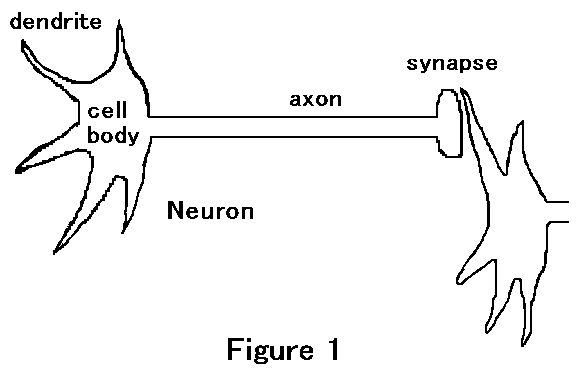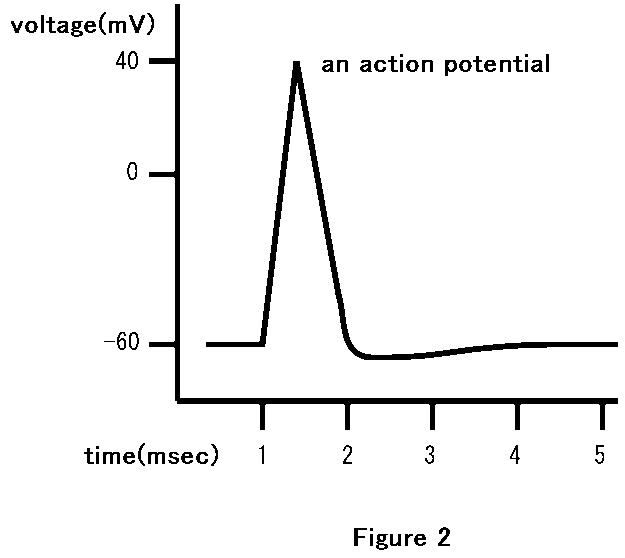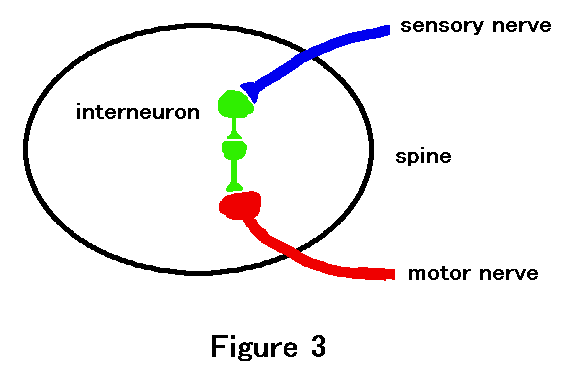The Action Potential as the Universal Coin
Neuron
A neuron is a specialized for information processing. It consists of three major parts: dendrites, a cell body, an axon. The axon ending connects to the dendrite of the next neuron, and there is a tiny space between two neurons. This connection is the synapse, in which the nerve signal is transmitted to the next neuron. Figure 1 shows the schema of neurons.
 Because there are many reviews of the neuron on the internet, we shall finish the general description of the neuron simply. If you want to learn basic neuroscience, please see Neuroscience For Kids. This site is good for adults. Let us turn to the main purpose of this knol. We want to show that the action potential, which is the major signal of neurons, can be regarded as the universal coin.
Because there are many reviews of the neuron on the internet, we shall finish the general description of the neuron simply. If you want to learn basic neuroscience, please see Neuroscience For Kids. This site is good for adults. Let us turn to the main purpose of this knol. We want to show that the action potential, which is the major signal of neurons, can be regarded as the universal coin.
Action Potential as the Universal Coin
We shall consider signals of neurons. In "What Is the Natural Number One?", I say that the perception of life is based on Plato's one. Also, an action potential of a neuron has properties of Plato's one. Then, I shall explain action potential below.
Neurons use two types of electric signals. First, localized graded signals are generated by input of other neurons via synapses or extrinsic stimulus such as light on a visual cell. These signals are localized and spread passively. Second, an action potential is generated by the sum of localized graded potentials. If it overs the threshold, an action potential is initiated. If it is once initiated, its amplitude and duration are fixed. Then, it can propagate a long distance. Figure 3 shows an action potential.
 The important feature of the action potentials is the universality (1).
The important feature of the action potentials is the universality (1).
An important feature of electrical signals is that they are virtually identical in all nerve cells of the body, whether they carry commands for movement, transmit messages about colors, shapes or painful stimuli, or interconnect various portions of the brain. A second important feature of signals is they are so similar in different animals that even a sophisticated investigator (like one of the authors of this book) is unable to tell with certainty whether a photographic record of an action potential is derived from the nerve fiber of whale, mouse, monkey, worm, tarantula, or professor. They are universal coins for the exchange of information in all nervous systems that have been investigated.
Thus, the action potential is the universal coin of the nervous system of all animals. That is, it has the basic properties of Plato's one: equality, indivisibility, invariability.
Furthermore, in Book áZ of Repubric, Socrates says "I mean, as I was saying, that arithmetic has a very great and elevating effect, compelling the soul to reason about abstract number, and rebelling against the introduction of visible or tangible objects into the argument." That is, Plato's one does not have sensory properties. Also, the action potential itself does not have them. Based on this feature, the extent of any sensory stimulus can be converted to the number of the action potentials.
The Flexion Withdrawal Reflex
An action potential of a sensory nerve represents the particular sense, and each sensory neuron has the particular receptive field. For example, there are many types of somatosensory neurons such as touch, temperature, body position and pain. They use the same action potential but its meaning is different for each neuron. However, it also has the meaning as the universal coin.
In order to show a role as the universal coin of the action potential, we shall consider the flexion withdrawal reflex (2). It is a spinal reflex, in which the limb is withdrawn from a damaging stimulus.
Touching a stove that is only slightly hot may produce moderately fast withdrawal only at the wrist and elbow, while touching a stove that is very hot invariably leads to a forceful contraction at all joints, leading to a rapid withdrawal of the entire limb.
In this example, the extent and the speed of the movement is roughly proportional to the degree of the heat. An action potential plays the role of the universal coin, so that heat can be changed into strength of the movement. Figure 6 shows the simplified schema of a part of flexion withdrawal reflex.
 Action potentials of the interneurons play the role of the universal coin in this reflex. The noxious stimulus carried by sensory nerve is converted into the number of them, and then they are changed to motor commands.
Action potentials of the interneurons play the role of the universal coin in this reflex. The noxious stimulus carried by sensory nerve is converted into the number of them, and then they are changed to motor commands.
Therefore, action potentials can digitize any type of sensory signal, so that the nervous system can compare different types of sensory informations. This digitization may be the base of the logical thinking.
References
(1) Martin, A. R., Wallace, B. G., Fuchs, P. A., Nicholls, J. G., From Neuron to Brain 4th edition, Sinauer Associates, 2001
(2) Kandel, E. R., Schwaltz, J. H., Jessel, T. M., Principles of Neural Science 4th edition, McGraw-Hill, 2000
Table of Contents



